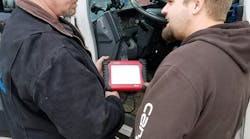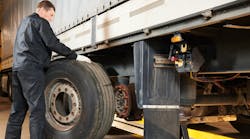While there are processes and procedures fleets can adopt to mitigate vehicle downtime, there are instances where lack of information on how to diagnose or repair a vehicle is still a major issue.
“An idle vehicle can cost a fleet over $1,000 a day,” says Marc Karon, director of legislative affairs for the Commercial Vehicle Solutions Network (CVSN).
CVSN is the largest association for the independent parts and service aftermarket distributors serving the transportation industry.
There are a number of advantages to allowing independent repair facilities access to the same diagnostic and repair information as certified dealers, Karon says.
- More service locations provide more options to the vehicle owner or fleet, reducing costs and downtime.
- It alleviates the requirement of finding a dealer that may be a significant distance from the vehicle’s current location, and subsequently the cost of a pricey tow.
- It lowers the overall cost of service by introducing more competition to the market.
To address the need for this information, a number of industry organizations and advocacy groups have taken strides on behalf of the aftermarket to get full access to the original equipment (OE) level vehicle diagnostic and repair information.
Previously available only to certified dealerships, or those willing to pay a premium price for the OE scan tool (if and when available), the vehicle maintenance and repair industry has come to an official agreement on sharing access to this information with the passing of a state-level Right to Repair Act and subsequent nationwide Memorandum of Understanding (MOU).
History and introduction of Right to Repair
The 1990 amendments to the U.S. EPA Clean Air Act added a requirement of automakers to have 100 percent of their vehicle’s fleets equipped with a standardized form of emissions monitoring, beginning with 1996 model year vehicles.
With that amendment came the standardization of on-board diagnostics, known as OBD-II. Every vehicle model year 1996 and beyond was required to have a standardized on-board diagnostics port accessible using a J-1962-specified 16-pin interface OBD-II diagnostic connector. Access to the on-board diagnostics port provides, among other things, information on a vehicle’s emission system data through the implementation of standard diagnostic trouble codes.
In other words, anyone with an OBD-II connector now had access, albeit limited to primarily engine and powertrain performance, to a vehicle’s information. Those OBD-II connectors are still what you see today on any light duty scan tool used in a repair shop.
“That inclusion of the OBD port, and the requirement on vehicles, signaled an increased use of technology for controlling larger portions of the vehicle, and the industry realized that was going to be a portal to creating barriers of access to diagnostics and repair information,” says Sheila Andrews, director of heavy duty programs at the Auto Care Association.
The Auto Care Association provides advocacy, educational, networking, technology, market intelligence and communications resources to the automotive industry.
Spearheaded by the Auto Care Association (then known as the Automotive Aftermarket Industry Association, or AAIA) and the Coalition for Auto Repair Equality (CARE), a number of aftermarket organizations ultimately joined together with a collective goal of obtaining access to OE diagnostic and repair information for both the light duty and heavy duty commercial vehicles. The initiative spurred the creation of the Right to Repair (R2R) movement.
In 2012, the Commonwealth of Massachusetts was the first state to launch and pass a ballot measure, known as Question 1, which required “motor vehicle manufacturers to allow vehicle owners and independent repair facilities in Massachusetts to have access to the same vehicle diagnostic and repair information made available to the manufacturers’ Massachusetts dealers and authorized repair facilities” according to ballot record documents.
The Motor Vehicle Owners’ Right to Repair Act was signed into Massachusetts state law in late 2013.
Coming to an agreement
While the original intention of the R2R movement was to include the breadth of over the road vehicles, the Massachusetts law covered vehicles at or below 10,000 lbs GVWR, or Class 1 and 2 vehicles.
To avoid a drawn out state-by-state legal battle following the passing of the Massachusetts R2R law, aftermarket industry organizations went to work to create a national agreement, or memorandum of understanding, with vehicle manufacturers. A separate MOU was drafted and signed for both light duty vehicles (Class 1 through 3) and for heavy duty vehicles (Class 4 through 8).
In early 2014, the AAIA and CARE, along with the Alliance of Automobile Manufacturers and Association of Global Automakers signed the MOU for light duty vehicles.
“[The MOU negotiations were] originally focused on light duty, but through the increased access to the requirement of emissions information, and negotiating through that process, it was apparent to us that the commercial vehicle industry needed to have its role and place in R2R as well,” Auto Care’s Andrews says.
To aid in the implementation of a heavy duty counterpart to the Right to Repair Act and subsequent light duty MOU, the Commercial Vehicle Solutions Network (CVSN) played a key role in the signing of the Heavy Duty MOU.
“CVSN initiated and financed a lobbying effort that convinced the Massachusetts legislature to include heavy duty commercial vehicles in the Massachusetts Right to Repair law,” CVSN’s Karon explains. “Once this occurred, the EMA (Truck & Engine Manufacturers Association) decided that the generation of a MOU was preferable to 50 different state laws. CVSN agreed to meet with the EMA and we brought other associations into the negotiations.”
Signed in August 2015, the Heavy Duty MOU included the following organizations: Commercial Vehicle Solutions Network, Heavy Duty Aftermarket Canada, Auto Care Association, the Equipment and Tool Institute and the Truck and Engine Manufacturers Association (EMA). EMA represents the original equipment heavy duty engine manufacturers, while the other organizations represent some aspect of the heavy duty aftermarket.
“EMA was a principal author and negotiator, with the other signatories, of the HDOH [heavy duty on-highway] MOU,” EMA president Jed Mandel says. “All of the parties recognized that addressing issues surrounding access to service information through an MOU based voluntary, national approach made the most sense.”
Key differences
Aside from the varied timelines for the signing of light duty and heavy duty MOUs, there are other differences within the vehicle segments to note.
“Because of the history with providing VIN information, the light duty vehicle manufacturers are much more used to working with the independent aftermarket and providing information – or what’s required to be provided,” Auto Care’s Andrews says. “That cultural shift of the vehicle manufacturers on the commercial side working with the independent aftermarket is really the biggest barrier at this point.”
That means, due to specing and the customization for as-built vehicle options available to the commercial vehicle market based on application needs, a standardized identification number to look up specs on an entire vehicle is not available.
“The biggest difference between the two MOUs is the VIN-to-part number requirement,” CVSN’s Karon adds. “On automobiles, variations within the make, model and year are minimal so determining the proper repair part to fix a car is not as difficult as with a commercial truck.
“Because of the vast optional parts on commercial vehicles, the MOU requires the OE to furnish the VIN-to-part number information so the repair can be done safely. That can be done through the scan tool so it only affects the specific repair. However, that is one area where we have the greatest non-compliance.”
Current status and challenges
In order for commercial vehicle and engine manufacturers to comply with the Heavy Duty MOU, there were some initial unforeseen challenges. One such obstacle was physically getting access to the OE software.
“Signing an agreement and getting the right software requires bridging a big divide,” CVSN’s Karon explains. “Some manufacturer’s software was integrated into their dealer packages so they had to create new software for independent service shops. Other manufacturers did not have a sales interface to sell the software and one had to be created. Still others were reluctant to follow the MOU and chose to be selective in what software they offered.”
The process so far has been to search out and test this information piecemeal, which can be a long and arduous process.
“You have to go website by website to each manufacturer to see what they’re making available through a web portal already,” Auto Care’s Andrews says. “You have to go ahead and purchase each individual subscription and, in some cases, initiate a service or repair ticket on a vehicle to find out what data is actually available. So, that’s where we’re seeing some gaps.”
“Most members of the EMA are complying to a certain extent,” she adds. “But, the issue that we’re running into is what type of information is available. We’re seeing some inconsistencies and gaps in information that are actually necessary for proper requirements. But most are attempting to comply on some level.”
“The current status is mixed,” Karon adds, of manufacturers providing this information. “Some OEs, like Cummins, are fully compliant. Other OEs have some work to do to become compliant. We are trying to work through the EMA to have discussions and commitments for these OEs on when they will become completely compliant with the MOU.”
While current verification methods prove time-consuming, an additional provision from the MOUs beginning with the 2018 model year vehicles may help streamline this process.
According to the official Heavy Duty MOU documents, for vehicles manufactured in 2018 and beyond, “manufacturers shall provide access to their onboard diagnostic and repair information system utilizing an online connection.”
The MOU goes on to detail that this system must include “internet-server based diagnostics” accessible through a personal shop computer and a non-proprietary vehicle communication interface, or VCI, that complies with TMC RP1210A SAE J2534 or ISO 22900 standards.
In other words, OEs must provide access to dealer-level diagnostic and repair information through a real-time online connection by way of a standardized device.
“When everything is available through that web-based or cloud-based system you’ll be able to see, in a much more automated way and immediate way, what is and what isn’t available, and where the gaps exist,” Andrews adds.
Next steps
Andrews says the Auto Care Association and its partners have continued working together with members of the EMA to confirm all engine manufacturers are adhering to the guidelines put in place with the Heavy Duty MOU.
“The 2018 requirements that are about to kick in requiring a standardized interface (VCI) requirement is the next immediate action within the MOU,” she says. “From that, we’ll be able to work much more significantly with the EMA on ensuring that their members are compliant.”
The ongoing challenge will be keeping up with the advancing vehicle technologies and verifying all agreed-upon information is available to the aftermarket.
“Because of the continually changing technology on commercial vehicles, finding the new areas of non-compliance is very difficult,” CVSN’s Karon says. “There are fewer independent service shops who work in the engine space [where most of the technology is] and getting fleets or independent service shops to report new software issues that surface is a problem for us going forward. In the automotive world, there are many more shops who can report problems.”
As information gaps are found, the associations representing the aftermarket will continue to notify EMA members and work with these manufacturers to address any issues.
“I do not believe that there have been significant challenges with EMA’s members following the guidelines in the MOU,” EMA’s Mandel says.
In the event a manufacturer is not providing the information outlined in the MOU, there is a means to file an official dispute.
“To date, no one has felt the need to trigger that process,” Mandel adds.
“One of the number-one things we want to ensure the industry continues to do – whether it’s an independent repair facility, a fleet, an owner-operator, a maintenance manager, anyone that is touching the commercial vehicle and would need that Right to Repair information – let us know if you find an issue, because we can document that,” Andrews says. “We can work with the [EMA] and their members to alleviate that lack of compliance. And then, it (has) started the documentation process of a lack of compliance, where we can then use a dispute resolution panel and potentially and statutory penalties that would exist through the state of Massachusetts.”
“The key to any successful MOU is the commitment of the parties,” Karon says. “I am still very hopeful that both the EMA and the vehicle manufacturers want this to work, both to avoid costly legislation and, more importantly, for the benefit of their customers.”




